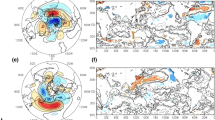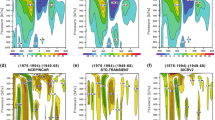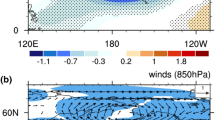Abstract
An analysis is made of the coherent patterns, or modes, of interannual variability of Southern Hemisphere 500 hPa geopotential height field under current and projected climate change scenarios. Using three separate multi-model ensembles (MMEs) of coupled model intercomparison project phase 5 (CMIP5) models, the interannual variability of the seasonal mean is separated into components related to (1) intraseasonal processes; (2) slowly-varying internal dynamics; and (3) the slowly-varying response to external changes in radiative forcing. In the CMIP5 RCP8.5 and RCP4.5 experiments, there is very little change in the twenty-first century in the intraseasonal component modes, related to the Southern annular mode (SAM) and mid-latitude wave processes. The leading three slowly-varying internal component modes are related to SAM, the El Niño–Southern oscillation (ENSO), and the South Pacific wave (SPW). Structural changes in the slow-internal SAM and ENSO modes do not exceed a qualitative estimate of the spatial sampling error, but there is a consistent increase in the ENSO-related variance. Changes in the SPW mode exceed the sampling error threshold, but cannot be further attributed. Changes in the dominant slowly-varying external mode are related to projected changes in radiative forcing. They reflect thermal expansion of the tropical troposphere and associated changes in the Hadley Cell circulation. Changes in the externally-forced associated variance in the RCP8.5 experiment are an order of magnitude greater than for the internal components, indicating that the SH seasonal mean circulation will be even more dominated by a SAM-like annular structure. Across the three MMEs, there is convergence in the projected response in the slow-external component.










Similar content being viewed by others
References
Allan RJ, Haylock MR (1993) Circulation features associated with the winter rainfall decrease in southwestern Australia. J Clim 6:1356–1367. doi:10.1175/1520-0442(1993)006<1356:CFAWTW>2.0.CO;2
Bayr T, Dommenget D, Martin T, Power SB (2014) The eastward shift of the Walker Circulation in response to global warming and its relationship to ENSO variability. Clim Dyn 43:2747–2763. doi:10.1007/s00382-014-2091-y
Bellenger H, Guilyardi E, Leloup J, Lengaigne M, Vialard J (2014) ENSO representation in climate models: from CMIP3 to CMIP5. Clim Dyn 42:1999–2018. doi:10.1007/s00382-013-1783-z
Boer GJ (2009) Changes in interannual variability and decadal potential predictability under global warming. J Clim 22:3098–3109. doi:10.1175/2008JCLI2835.1
CCIA (2015) Climate change in Australia. Information for Australia’s natural resource management regions: Technical report. CSIRO and Bureau of Meteorology, Australia. http://climatechangeinaustralia.gov.au/media/ccia/2.1.4/cms_page_media/168/CCIA_PROJECTIONS_TECHNICAL_REPORT.pdf
Chadwick R, Boutle I, Martin G (2013) Spatial patterns of precipitation change in CMIP5: why the rich do not get richer in the tropics. J Clim 26:3803–3822. doi:10.1175/JCLI-D-12-00543.1
Collins M et al (2013) Long-term climate change: projections, commitments and irreversibility. In: Stocker TF et al (eds) Climate change 2013: the physical science basis contribution of working group I to the fifth assessment report of the intergovernmental panel on climate change. Cambridge University Press, Cambridge, pp 1029–1136
Compo GP et al (2011) The twentieth century reanalysis project. Q J R Meteorol Soc 137:1–28. doi:10.1002/qj.776
Flato G et al (2013) Evaluation of climate models. In: Stocker TF et al (eds) Climate change 2013: the physical science basis contribution of working group I to the fifth assessment report of the intergovernmental panel on climate change. Cambridge University Press, Cambridge, pp 741–866
Fogt RL, Bromwich DH, Hines KM (2011) Understanding the SAM influence on the South Pacific ENSO teleconnection. Clim Dyn 36:1555–1576. doi:10.1007/s00382-010-0905-0
Frederiksen JS, Frederiksen CS (1993) Southern Hemisphere storm tracks, blocking, and low-frequency anomalies in a primitive equation model. J Atmos Sci 50:3148–3163. doi:10.1175/1520-0469(1993)050<3148:SHSTBA>2.0.CO;2
Frederiksen JS, Frederiksen CS (2007) Interdecadal changes in Southern Hemisphere winter storm track modes. Tellus A 59:599–617. doi:10.1111/j.1600-0870.2007.00264.x
Frederiksen CS, Grainger S (2015) The role of external forcing in prolonged trends in Australian rainfall. Clim Dyn. doi:10.1007/s00382-015-2482-8
Frederiksen CS, Zheng X (2007a) Variability of seasonal-mean fields arising from intraseasonal variability. Part 3: application to SH winter and summer circulations. Clim Dyn 28:849–866. doi:10.1007/s00382-006-0214-9
Frederiksen CS, Zheng X (2007b) Coherent patterns of interannual variability of the atmospheric circulation: the role of intraseasonal variability. In: Denier J, Frederiksen JS (eds) Frontiers in turbulence and coherent structures. World scientific lecture notes in complex systems, vol 6. World Scientific Publications, Singapore, pp 87–120. doi:10.1142/6320
Frederiksen CS, Zheng X, Grainger S (2014) Teleconnections and predictive characteristics of Australian seasonal rainfall. Clim Dyn 43:1381–1408. doi:10.1007/s00382-013-1952-0
Frederiksen CS, Zheng X, Grainger S (2015) Simulated modes of inter-decadal predictability in sea surface temperature. Clim Dyn. doi:10.1007/s00382-015-2699-6
Freitas ACV, Rao VB (2011) Multidecadal and interannual changes of stationary Rossby waves. Q J R Meteorol Soc 137:2157–2173. doi:10.1002/qj.894
Grainger S, Frederiksen CS, Zheng X (2011a) Estimating components of covariance between two climate variables using model ensembles. ANZIAM J 52:C318–C332. http://journal.austms.org.au/ojs/index.php/ANZIAMJ/article/view/3928
Grainger S, Frederiksen CS, Zheng X, Fereday D, Folland CK, Jin EK, Kinter JL, Knight JR, Schubert S, Syktus J (2011b) Modes of variability of Southern Hemisphere atmospheric circulation estimated by AGCMs. Clim Dyn 36:473–490. doi:10.1007/s00382-009-0720-7
Grainger S, Frederiksen CS, Zheng X (2013) Modes of interannual variability of Southern Hemisphere atmospheric circulation in CMIP3 models: assessment and projections. Clim Dyn 41:479–500. doi:10.1007/s00382-012-1659-7
Grainger S, Frederiksen CS, Zheng X (2014) Assessment of modes of interannual variability of Southern Hemisphere atmospheric circulation in CMIP5 models. J Clim 27:8107–8125. doi:10.1175/JCLI-D-14-00251.1
Hawkins E, Sutton R (2011) The potential to narrow uncertainty in projections of regional precipitation change. Clim Dyn 37:407–418. doi:10.1007/s00382-010-0810-6
Holton JR (2004) An introduction to dynamic meteorology. Elsevier Academic Publishing, Burlington
Hope PK, Drosdowsky W, Nicholls N (2006) Shifts in the synoptic systems influencing southwest Western Australia. Clim Dyn 26:751–764. doi:10.1007/s00382-006-0115-y
Kalnay E et al (1996) The NCEP/NCAR 40-year reanalysis project. Bull Am Meteorol Soc 77:437–471. doi:10.1175/1520-0477(1996)077<0437:TNYRP>2.0.CO;2
Kidson JW (1999) Principal modes of Southern Hemisphere low-frequency variability obtained from NCEP–NCAR reanalyses. J Clim 12:2808–2830. doi:10.1175/1520-0442(1999)012<2808:PMOSHL>2.0.CO;2
Knutti R, Furrer R, Tebaldi C, Cermak J, Meehl GA (2010) Challenges in combining projections from multiple climate models. J Clim 23:2739–2758. doi:10.1175/2009JCLI3361.1
Leith CE (1973) The standard error of time-average estimates of climatic means. J Appl Meteorol 12:1066–1069. doi:10.1175/1520-0450(1973)012<1066:TSEOTA>2.0.CO;2
Leith CE (1975) Climate response and fluctuation dissipation. J Atmos Sci 32:2022–2026. doi:10.1175/1520-0469(1975)032<2022:CRAFD>2.0.CO;2
Marshall GJ (2003) Trends in the Southern annular mode from observations and reanalyses. J Clim 16:4134–4143. doi:10.1175/1520-0442(2003)016<4134:TITSAM>2.0.CO;2
McSweeney CF, Jones RG, Booth BBB (2012) Selecting ensemble members to provide regional climate change information. J Clim 25:7100–7121. doi:10.1175/JCLI-D-11-00526.1
Meehl GA, Covey C, Delworth T, Latif M, McAvaney B, Mitchell JFB, Stouffer RJ, Taylor KE (2007) The WCRP CMIP3 multimodel dataset: a new era in climate change research. Bull Am Meteorol Soc 88:1383–1394. doi:10.1175/BAMS-88-9-1383
Mo KC (2000) Relationships between low-frequency variability in the Southern Hemisphere and sea surface temperature anomalies. J Clim 13:3599–3610. doi:10.1175/1520-0442(2000)013<3599:RBLFV>2.0.CO;2
Monahan AH, Fyfe JC, Ambaum MHP, Stephenson DB, North GR (2009) Empirical orthogonal functions: the medium is the message. J Clim 22:6501–6514. doi:10.1175/2009JCLI3062.1
Nguyen H, Evans A, Lucas C, Smith I, Timbal B (2013) The Hadley circulation in reanalyses: climatology, variability, and change. J Clim 26:3357–3376. doi:10.1175/JCLI-D-12-00224.1
North GR, Bell TL, Cahalan RF, Moeng FJ (1982) Sampling errors in the estimation of empirical orthogonal functions. Mon Weather Rev 110:699–706. doi:10.1175/1520-0493(1982)110<0699:SEITEO>2.0.CO;2
Polvani LM, Waugh DW, Correa GJP, Son S-W (2011) Stratospheric ozone depletion: the main driver of twentieth-century atmospheric circulation changes in the Southern Hemisphere. J Clim 24:795–812. doi:10.1175/2010JCLI3772.1
Rauthe M, Hense A, Paeth H (2004) A model intercomparison study of climate change-signals in extratropical circulation. Int J Climatol 24:643–662. doi:10.1002/joc.1025
Rayner NA, Parker DE, Horton EB, Folland CK, Alexander LV, Rowell DP, Kent EC, Kaplan A (2003) Global analyses of sea surface temperature, sea ice, and night marine air temperature since the late nineteenth century. J Geophys Res 108(D14):4407. doi:10.1029/2002JD002670
Renwick JA (2005) Persistent positive anomalies in the Southern Hemisphere circulation. Mon Weather Rev 133:977–988. doi:10.1175/MWR2900.1
Rowell DP, Folland CK, Maskell K, Ward MN (1995) Variability of summer rainfall over tropical North Africa (1906–92): observations and modelling. Q J R Meteorol Soc 121:669–704. doi:10.1002/qj.49712152311
Sandeep S, Stordal F, Sardeshmukh PD, Compo GP (2014) Pacific Walker Circulation variability in coupled and uncoupled climate models. Clim Dyn 43:103–117. doi:10.1007/s00382-014-2135-3
Shepherd TG (2014) Atmospheric circulation as a source of uncertainty in climate change projections. Nature Geosci 7:703–708. doi:10.1038/ngeo2253
Simpson IR, Blackburn M, Haigh JD (2009) The role of eddies in driving the tropospheric response to stratospheric heating perturbations. J Atmos Sci 66:1347–1365. doi:10.1175/2008JAS2758.1
Simpson IR, Shepherd TG, Hitchcock P, Scinocca JF (2013) Southern annular mode dynamics in observations and models. Part II: Eddy feedbacks. J Clim 26:5220–5241. doi:10.1175/JCLI-D-12-00495.1
Staten PW, Rutz JJ, Reichler T, Lu J (2012) Breaking down the tropospheric circulation response by forcing. Clim Dyn 39:2361–2375. doi:10.1007/s00382-011-1267-y
Taylor KE (2001) Summarizing multiple aspects of model performance in a single diagram. J Geophys Res 106:7183–7192. doi:10.1029/2000JD900719
Taylor KE, Stouffer RJ, Meehl GA (2012) An overview of CMIP5 and the experiment design. Bull Am Meteorol Soc 93:485–498. doi:10.1175/BAMS-D-11-00094.1
van Vuuren DP et al (2011) The representative concentration pathways: an overview. Clim Chang 109:5–31. doi:10.1007/s10584-011-0148-z
Wilks DS (2006) Statistical methods in the atmospheric sciences. Academic Press, San Diego, p 648
Yokohata T, Annan JD, Collins M, Jackson CS, Shiogama H, Watanabe M, Emori S, Yoshimori M, Abe M, Webb MJ, Hargreaves JC (2013) Reliability and importance of structural diversity of climate model ensembles. Clim Dyn 41:2745–2763. doi:10.1007/s00382-013-1733-9
Zhang Y, Wallace JM, Battisti DS (1997) ENSO-like interdecadal variability: 1900–93. J Clim 10:1004–1020. doi:10.1175/1520-0442(1997)010<1004:ELIV>2.0.CO;2
Zheng X, Frederiksen CS (1999) Validating interannual variability in an ensemble of AGCM simulations. J Clim 12:2386–2396. doi:10.1175/1520-0442(1999)012<2386:VIVIAE>2.0.CO;2
Zheng X, Frederiksen CS (2004) Variability of seasonal-mean fields arising from intraseasonal variability: part 1, methodology. Clim Dyn 23:177–191. doi:10.1007/s00382-004-0428-7
Zheng X, Straus DM, Frederiksen CS, Grainger S (2009) Potentially predictable patterns of extratropical tropospheric circulation in an ensemble of climate simulations with the COLA AGCM. Q J R Meteorol Soc 135:1816–1829. doi:10.1002/qj.492
Zheng X, Sugi M, Frederiksen CS (2004) Interannual variability and predictability in an ensemble of climate simulations with the MRI-JMA AGCM. J Meteorol Soc Japan 82:1–18. doi:10.2151/jmsj.82.1
Zwiers FW (1996) Interannual variability and predictability in an ensemble of AMIP climate simulations conducted with the CCC GCM2. Clim Dyn 12:825–847. doi:10.1007/s003820050146
Acknowledgments
CMIP5 data is available from http://pcmdi9.llnl.gov. We acknowledge the World Research Programme’s Working Group on Coupled Modelling, which is responsible for CMIP, and we thank the climate modelling groups for producing and making available their model output. For CMIP, the U.S. Department of Energy’s Program for Climate Model Diagnosis and Intercomparison provides coordinating support and led development of software infrastructure in partnership with the Global Organization for Earth System Science Portals. We acknowledge the resources and support of the National Computational Infrastructure at the Australian National University for maintaining the CMIP5 data at the Australian Earth Systems Grid node. J. Sisson provided invaluable assistance in pre-processing the CMIP5 data. This work is supported by the Australian Government Department of the Environment through the Australian Climate Change Science Program. X. Zheng is supported by the National Basic Research Program of China (Grant No. 2012CB956203). Comments from A. Dowdy, S. Osbrough and two anonymous reviewers helped to considerably improve this paper.
Author information
Authors and Affiliations
Corresponding author
Appendix
Appendix
The statistical significance of the covariances between the associated time series of the SH 500 hPa geopotential height interannual modes of variability and the corresponding components of a climate field (Sect. 3.2) is able to be estimated through testing of likelihood ratios. Following Grainger et al. (2011a), the monthly anomalies of the associated time series, p sym , and climate field anomalies, x sym ′, are respectively defined as
and
where i is the index of (1,…, I) modes of variability for a component and j the index of (1,…, J) geographical locations for the climate field. Note that the climate field need not be on the same spatial grid as the modes of variability. The alternative hypotheses are that the covariance between the S-mode, SI-mode and SE-mode associated time series and the corresponding components of the climate field are represented by Eqs. (5), (8) and (9) respectively. For convenience, these are written here as
and
The null hypotheses are that the estimated covariances are solely due to the intraseasonal (for the slow and slow-internal components) or internal (for the slow-external component) terms in Eqs. (14)–(16). Assuming statistical independence of the components this implies, respectively, that
and
For each (i, j) pair for each component, the expectation values for each hypothesis in Eqs. (14)–(19) can be expressed as a 2 × 2 cross-covariance matrix. Thus for the slow component alternative hypothesis, from Eq. (14) we obtain
where μ sy ≡ β y + δ sy and μ sy ′ ≡ β y ′ + δ sy ′, and the (i) and (j) notation has been dropped. Similarly from Eq. (17)
For the slow-internal component, Eqs. (15) and (18) are used to obtain
and
For the slow-external component, Eqs. (16) and (19) are used to obtain
and
All terms in Eqs. (20)–(25) are able to be calculated from monthly or seasonal mean moments of p(i) and x′(j); see Zheng et al. (2004) for examples of the relevant equations. The local Chi squared statistic, with one degree of freedom, for each (i, j) pair for each component is
where LH0 and LHA are the log-likelihoods of the null and alternative hypotheses respectively, and are calculated using the multivariate normal distribution (e.g. Wilks 2006) with the appropriate cross-covariance matrices V 0 and V.
Rights and permissions
About this article
Cite this article
Grainger, S., Frederiksen, C.S. & Zheng, X. Projections of Southern Hemisphere atmospheric circulation interannual variability. Clim Dyn 48, 1187–1211 (2017). https://doi.org/10.1007/s00382-016-3135-2
Received:
Accepted:
Published:
Issue Date:
DOI: https://doi.org/10.1007/s00382-016-3135-2




